wheel size MITSUBISHI L200 2015 Owner's Manual (in English)
[x] Cancel search | Manufacturer: MITSUBISHI, Model Year: 2015, Model line: L200, Model: MITSUBISHI L200 2015Pages: 418, PDF Size: 25.8 MB
Page 28 of 418
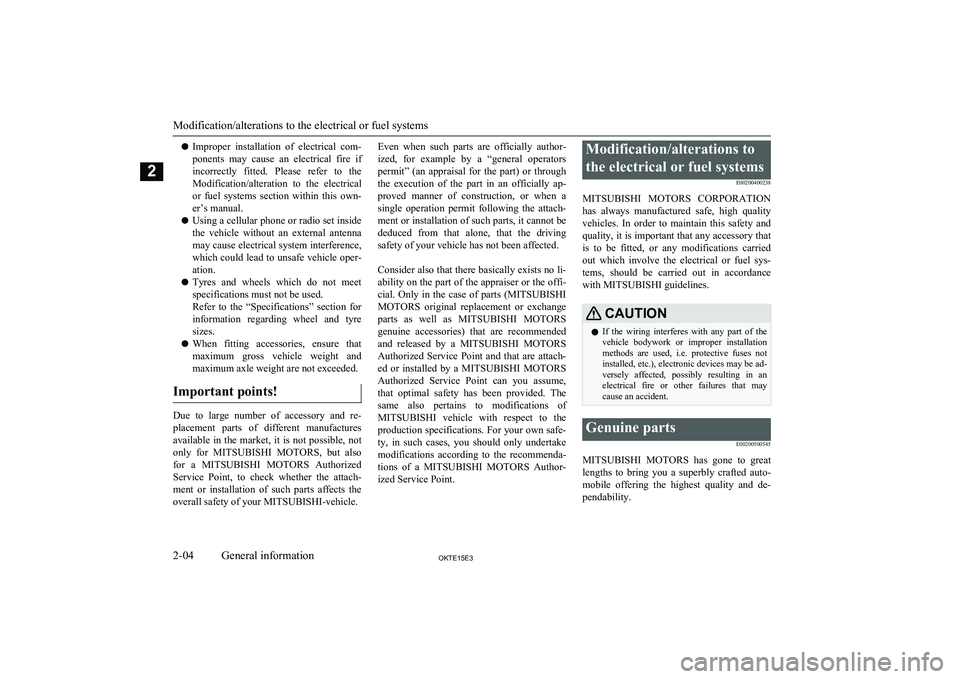
lImproper installation of electrical com-
ponents may cause an electrical fire if
incorrectly fitted. Please refer to the Modification/alteration to the electrical
or fuel systems section within this own- er’s manual.
l Using a cellular phone or radio set inside
the vehicle without an external antenna
may cause electrical system interference,
which could lead to unsafe vehicle oper- ation.
l Tyres and wheels which do not meet
specifications must not be used.
Refer to the “Specifications” section for information regarding wheel and tyre
sizes.
l When fitting accessories, ensure that
maximum gross vehicle weight and
maximum axle weight are not exceeded.
Important points!
Due to large number of accessory and re- placement parts of different manufactures available in the market, it is not possible, not
only for MITSUBISHI MOTORS , but also
for a MITSUBISHI MOTORS Authorized
Service Point, to check whether the attach-
ment or installation of such parts affects the overall safety of your MITSUBISHI-vehicle.
Even when such parts are officially author-
ized, for example by a “general operators permit” (an appraisal for the part) or throughthe execution of the part in an officially ap-
proved manner of construction, or when a single operation permit following the attach-
ment or installation of such parts, it cannot be deduced from that alone, that the driving
safety of your vehicle has not been affected.
Consider also that there basically exists no li- ability on the part of the appraiser or the offi- cial. Only in the case of parts ( MITSUBISHI
MOTORS original replacement or exchange
parts as well as MITSUBISHI MOTORS
genuine accessories) that are recommended and released by a MITSUBISHI MOTORS
Authorized Service Point and that are attach-
ed or installed by a MITSUBISHI MOTORS
Authorized Service Point can you assume, that optimal safety has been provided. Thesame also pertains to modifications of
MITSUBISHI vehicle with respect to the
production specifications. For your own safe-
ty, in such cases, you should only undertake
modifications according to the recommenda- tions of a MITSUBISHI MOTORS Author-
ized Service Point.Modification/alterations to
the electrical or fuel systems E00200400238
MITSUBISHI MOTORS CORPORATION
has always manufactured safe, high quality vehicles. In order to maintain this safety and
quality, it is important that any accessory that is to be fitted, or any modifications carried
out which involve the electrical or fuel sys- tems, should be carried out in accordancewith MITSUBISHI guidelines.CAUTIONl If the wiring interferes with any part of the
vehicle bodywork or improper installation methods are used, i.e. protective fuses not
installed, etc.), electronic devices may be ad- versely affected, possibly resulting in an
electrical fire or other failures that may cause an accident.Genuine parts
E00200500545
MITSUBISHI MOTORS has gone to great
lengths to bring you a superbly crafted auto-
mobile offering the highest quality and de- pendability.
Modification/alterations to the electrical or fuel systems
2-04OKTE15E3General information2
Page 174 of 418
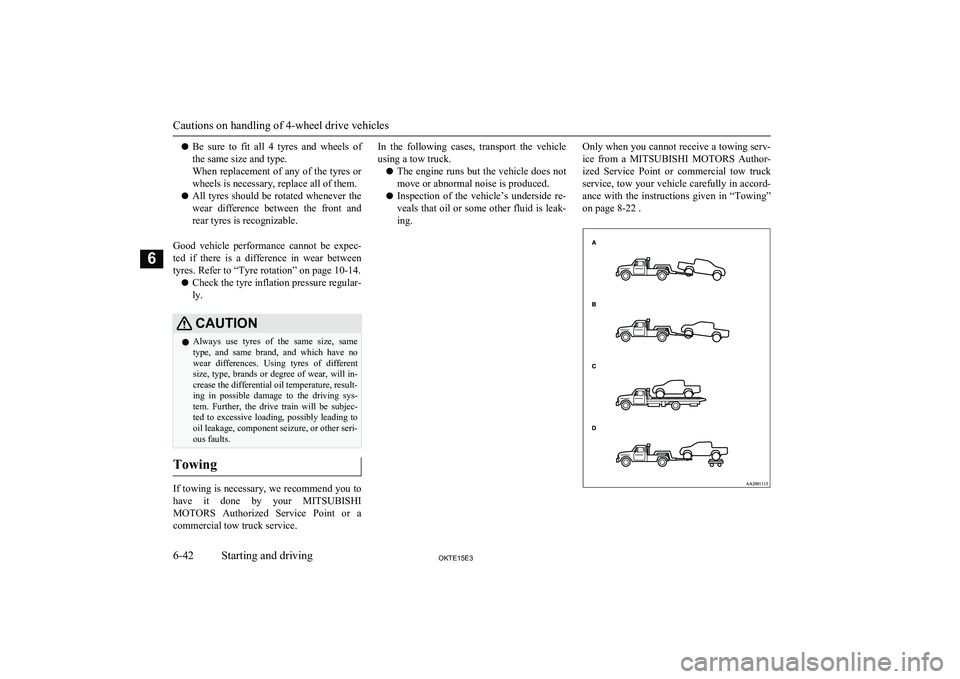
lBe sure to fit all 4 tyres and wheels of
the same size and type.
When replacement of any of the tyres or wheels is necessary, replace all of them.
l All tyres should be rotated whenever the
wear difference between the front and rear tyres is recognizable.
Good vehicle performance cannot be expec- ted if there is a difference in wear between
tyres. Refer to “Tyre rotation” on page 10-14.
l Check the tyre inflation pressure regular-
ly.CAUTIONl Always use tyres of the same size, same
type, and same brand, and which have no wear differences. Using tyres of different
size, type, brands or degree of wear, will in- crease the differential oil temperature, result-
ing in possible damage to the driving sys-
tem. Further, the drive train will be subjec-
ted to excessive loading, possibly leading to oil leakage, component seizure, or other seri-
ous faults.
Towing
If towing is necessary, we recommend you to
have it done by your MITSUBISHI
MOTORS Authorized Service Point or a
commercial tow truck service.
In the following cases, transport the vehicle
using a tow truck.
l The engine runs but the vehicle does not
move or abnormal noise is produced.
l Inspection of the vehicle’s underside re-
veals that oil or some other fluid is leak- ing.Only when you cannot receive a towing serv-ice from a MITSUBISHI MOTORS Author-
ized Service Point or commercial tow truck
service, tow your vehicle carefully in accord- ance with the instructions given in “Towing”
on page 8-22 .
Cautions on handling of 4-wheel drive vehicles
6-42OKTE15E3Starting and driving6
Page 178 of 418

CAUTIONlEven the ABS cannot prevent the natural
laws of physics from acting on the vehicle. Itcannot for instance avoid accidents that may
result from excessive speed on bends or fol- lowing another vehicle too closely or aqua- planing. It should remain the driver’s task to
observe safety precautions to judge speeds and brake applications correctly in such con-
ditions.
l Be sure to use tyres of the same type and
size on 4 wheels.
If tyre types or sizes are mixed, ABS may not function normally.
l Never install a limited-slip differential,
which is not a MITSUBISHI MOTORS gen-
uine part, as the ABS may not function nor-
mally.
We recommend you to consult a MITSUBISHI MOTORS Authorized Serv-
ice Point.ABS warning lamp
E00607201164
The ABS warning lamp should illuminate
when the ignition switch is turned “ON”, and
should go off in a few seconds.
CAUTIONl If the warning lamp stays on or does not illu-
minate when you start the vehicle, it indi-
cates that the ABS is not functioning and
that only the standard brake system is in op-
eration. (In this condition the standard hy- draulic brake system will still function.) We
recommend you to have your vehicle inspec- ted as soon as possible.NOTEl On vehicles with the rear differential lock,
ABS and the active stability & traction con-
trol (ASTC) functions are suspended while the rear differential lock is activated.
ASTC indication lamp, Active Stability
Control function OFF indication lamp, ABS warning lamp and brake warning lamp are
illuminated while these functions are sus- pended.
It does not indicate a problem. When the
rear differential lock is disengaged, these lamps go out and function again.
Refer to “ASTC indication lamp, ASTC
OFF indication lamp” on page 6-49.
l On vehicles with rear differential lock, ABS
functionality is suspended while the rear dif- ferential lock is operating.
The ABS warning lamp is illuminated while ABS functionality is suspended. It does notindicate a problem. When the rear differen-
tial lock is disengaged, the ABS warning
lamp goes off and the ABS functions again.
Refer to “Rear differential lock” on page
6-34.
Anti-lock brake system (ABS)*
6-46OKTE15E3Starting and driving6
Page 180 of 418
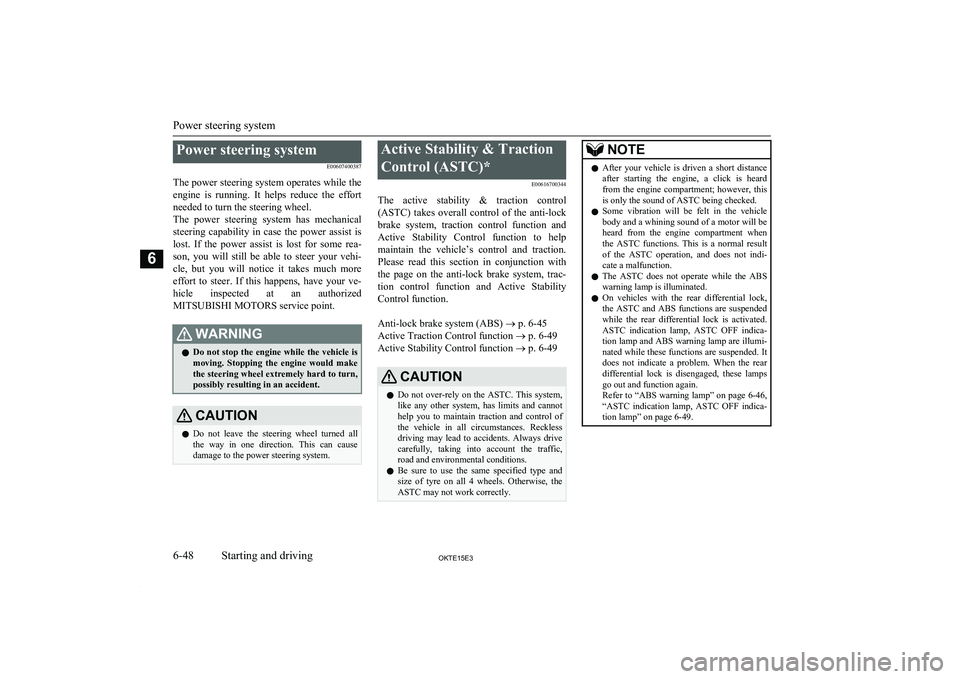
Power steering systemE00607400387
The power steering system operates while the
engine is running. It helps reduce the effort needed to turn the steering wheel.
The power steering system has mechanical
steering capability in case the power assist is lost. If the power assist is lost for some rea-
son, you will still be able to steer your vehi-
cle, but you will notice it takes much more effort to steer. If this happens, have your ve-
hicle inspected at an authorized MITSUBISHI MOTORS service point.WARNINGl Do not stop the engine while the vehicle is
moving. Stopping the engine would make
the steering wheel extremely hard to turn, possibly resulting in an accident.CAUTIONl Do not leave the steering wheel turned all
the way in one direction. This can causedamage to the power steering system.Active Stability & Traction
Control (ASTC)* E00616700344
The active stability & traction control (ASTC) takes overall control of the anti-lockbrake system, traction control function and Active Stability Control function to help
maintain the vehicle’s control and traction. Please read this section in conjunction with the page on the anti-lock brake system, trac- tion control function and Active Stability
Control function.
Anti-lock brake system (ABS) ® p. 6-45
Active Traction Control function ® p. 6-49
Active Stability Control function ® p. 6-49CAUTIONl Do not over-rely on the ASTC. This system,
like any other system, has limits and cannot
help you to maintain traction and control of
the vehicle in all circumstances. Reckless
driving may lead to accidents. Always drive carefully, taking into account the traffic,road and environmental conditions.
l Be sure to use the same specified type and
size of tyre on all 4 wheels. Otherwise, the
ASTC may not work correctly.NOTEl After your vehicle is driven a short distance
after starting the engine, a click is heard from the engine compartment; however, this
is only the sound of ASTC being checked.
l Some vibration will be felt in the vehicle
body and a whining sound of a motor will be heard from the engine compartment when the ASTC functions. This is a normal result
of the ASTC operation, and does not indi- cate a malfunction.
l The ASTC does not operate while the ABS
warning lamp is illuminated.
l On vehicles with the rear differential lock,
the ASTC and ABS functions are suspended
while the rear differential lock is activated. ASTC indication lamp, ASTC OFF indica-tion lamp and ABS warning lamp are illumi-
nated while these functions are suspended. It
does not indicate a problem. When the rear differential lock is disengaged, these lamps
go out and function again.
Refer to “ABS warning lamp” on page 6-46,
“ASTC indication lamp, ASTC OFF indica-
tion lamp” on page 6-49.
Power steering system
6-48OKTE15E3Starting and driving6
Page 330 of 418
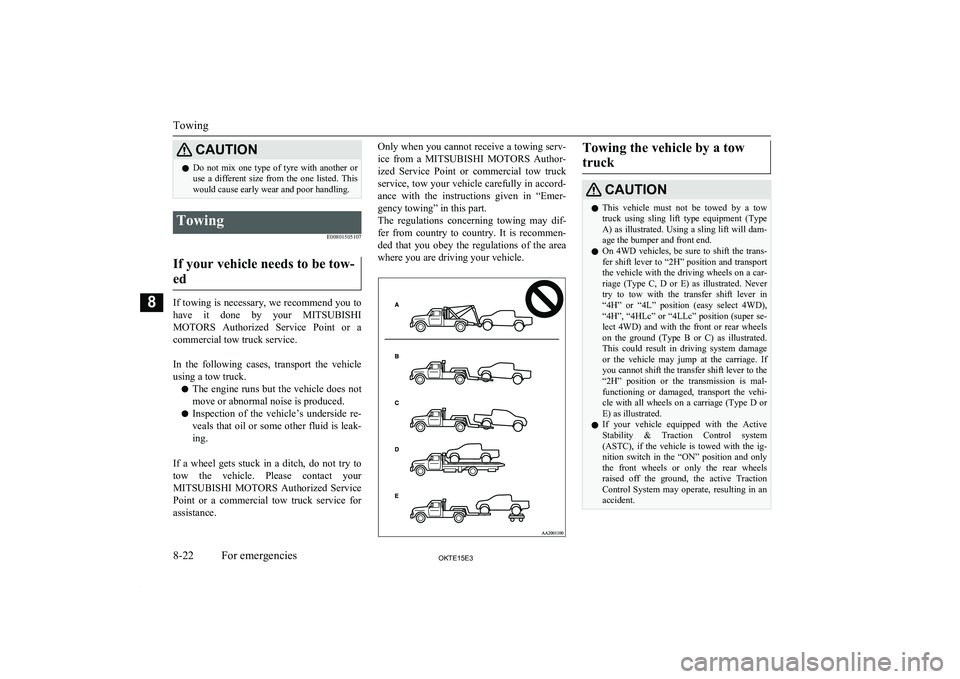
CAUTIONlDo not mix one type of tyre with another or
use a different size from the one listed. This
would cause early wear and poor handling.Towing
E00801505107
If your vehicle needs to be tow-
ed
If towing is necessary, we recommend you to have it done by your MITSUBISHI
MOTORS Authorized Service Point or a
commercial tow truck service.
In the following cases, transport the vehicle
using a tow truck.
l The engine runs but the vehicle does not
move or abnormal noise is produced.
l Inspection of the vehicle’s underside re-
veals that oil or some other fluid is leak- ing.
If a wheel gets stuck in a ditch, do not try to tow the vehicle. Please contact your
MITSUBISHI MOTORS Authorized Service
Point or a commercial tow truck service for assistance.
Only when you cannot receive a towing serv-
ice from a MITSUBISHI MOTORS Author-
ized Service Point or commercial tow truck
service, tow your vehicle carefully in accord- ance with the instructions given in “Emer-gency towing” in this part.
The regulations concerning towing may dif-
fer from country to country. It is recommen-
ded that you obey the regulations of the area where you are driving your vehicle.Towing the vehicle by a tow
truckCAUTIONl This vehicle must not be towed by a tow
truck using sling lift type equipment (Type A) as illustrated. Using a sling lift will dam-age the bumper and front end.
l On 4WD vehicles, be sure to shift the trans-
fer shift lever to “2H” position and transport
the vehicle with the driving wheels on a car- riage (Type C, D or E) as illustrated. Never
try to tow with the transfer shift lever in
“4H” or “4L” position (easy select 4WD),
“4H”, “4HLc” or “4LLc” position (super se- lect 4WD) and with the front or rear wheels
on the ground (Type B or C) as illustrated.
This could result in driving system damage or the vehicle may jump at the carriage. If you cannot shift the transfer shift lever to the “2H” position or the transmission is mal-
functioning or damaged, transport the vehi- cle with all wheels on a carriage (Type D or E) as illustrated.
l If your vehicle equipped with the Active
Stability & Traction Control system
(ASTC), if the vehicle is towed with the ig-
nition switch in the “ON” position and only the front wheels or only the rear wheels
raised off the ground, the active Traction Control System may operate, resulting in an
accident.
Towing
8-22OKTE15E3For emergencies8
Page 355 of 418
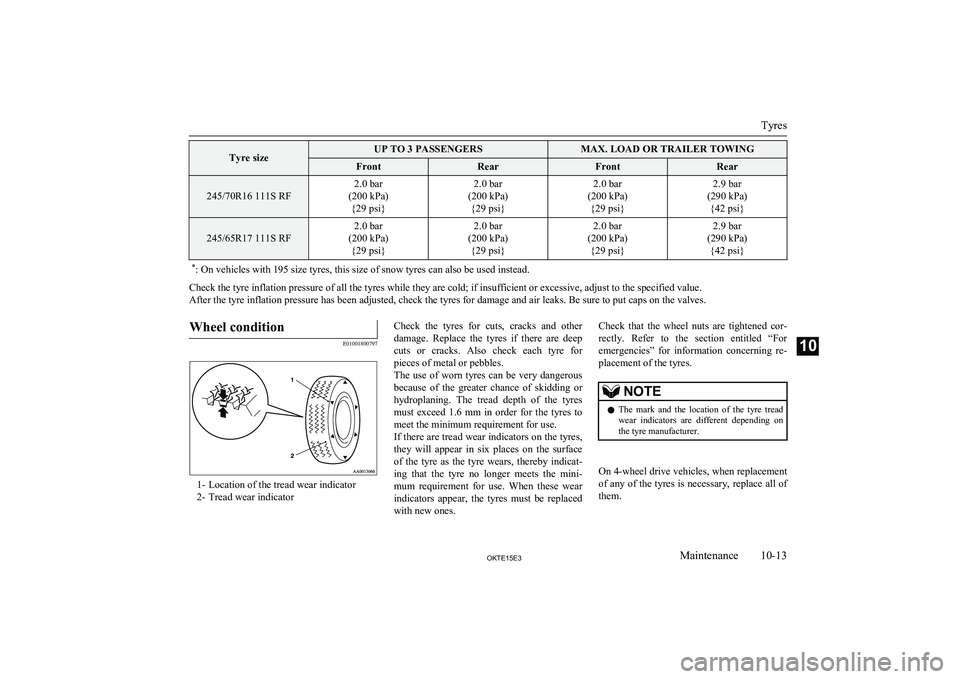
Tyre sizeUP TO 3 PASSENGERSMAX. LOAD OR TRAILER TOWINGFrontRearFrontRear
245/70R16 111S RF
2.0 bar
(200 kPa) {29 psi}2.0 bar
(200 kPa) {29 psi}2.0 bar
(200 kPa) {29 psi}2.9 bar
(290 kPa) {42 psi}
245/65R17 111S RF
2.0 bar
(200 kPa) {29 psi}2.0 bar
(200 kPa) {29 psi}2.0 bar
(200 kPa) {29 psi}2.9 bar
(290 kPa) {42 psi}* : On vehicles with 195 size tyres, this size of snow tyres can also be used instead.
Check the tyre inflation pressure of all the tyres while they are cold; if insufficient or excessive, adjust to the specified value.
After the tyre inflation pressure has been adjusted, check the tyres for damage and air leaks. Be sure to put caps on the valves.
Wheel condition
E01001800797
1- Location of the tread wear indicator
2- Tread wear indicator
Check the tyres for cuts, cracks and other
damage. Replace the tyres if there are deep
cuts or cracks. Also check each tyre for pieces of metal or pebbles.
The use of worn tyres can be very dangerous
because of the greater chance of skidding or
hydroplaning. The tread depth of the tyres
must exceed 1.6 mm in order for the tyres to meet the minimum requirement for use.
If there are tread wear indicators on the tyres,
they will appear in six places on the surface of the tyre as the tyre wears, thereby indicat- ing that the tyre no longer meets the mini-
mum requirement for use. When these wear
indicators appear, the tyres must be replaced
with new ones.Check that the wheel nuts are tightened cor-
rectly. Refer to the section entitled “For emergencies” for information concerning re-
placement of the tyres.NOTEl The mark and the location of the tyre tread
wear indicators are different depending on
the tyre manufacturer.
On 4-wheel drive vehicles, when replacement of any of the tyres is necessary, replace all of
them.
Tyres
10-13OKTE15E3Maintenance10
Page 356 of 418
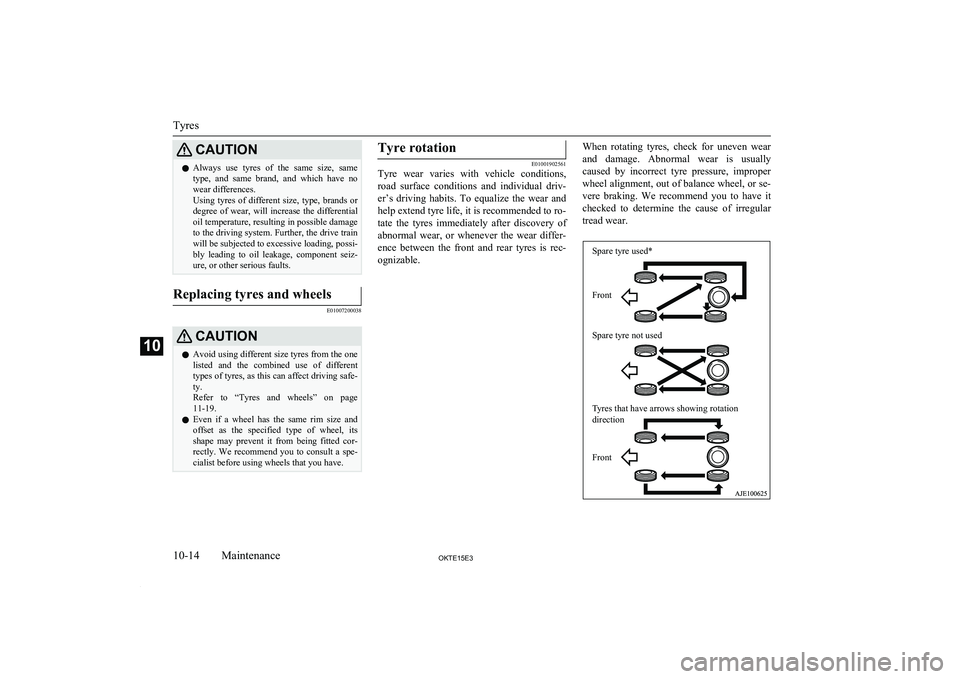
CAUTIONlAlways use tyres of the same size, same
type, and same brand, and which have no wear differences.
Using tyres of different size, type, brands or
degree of wear, will increase the differential
oil temperature, resulting in possible damage to the driving system. Further, the drive train
will be subjected to excessive loading, possi- bly leading to oil leakage, component seiz-ure, or other serious faults.Replacing tyres and wheels
E01007200038
CAUTIONl Avoid using different size tyres from the one
listed and the combined use of different
types of tyres, as this can affect driving safe- ty.
Refer to “Tyres and wheels” on page
11-19.
l Even if a wheel has the same rim size and
offset as the specified type of wheel, its
shape may prevent it from being fitted cor- rectly. We recommend you to consult a spe-
cialist before using wheels that you have.Tyre rotation
E01001902561
Tyre wear varies with vehicle conditions,
road surface conditions and individual driv- er’s driving habits. To equalize the wear andhelp extend tyre life, it is recommended to ro-
tate the tyres immediately after discovery of
abnormal wear, or whenever the wear differ- ence between the front and rear tyres is rec-
ognizable.
When rotating tyres, check for uneven wear
and damage. Abnormal wear is usually caused by incorrect tyre pressure, improper wheel alignment, out of balance wheel, or se-
vere braking. We recommend you to have it checked to determine the cause of irregular
tread wear.
Tyres
10-14OKTE15E3Maintenance10 Spare tyre used*
Front
Front
Tyres that have arrows showing rotation
direction
Spare tyre not used
Page 357 of 418

*-If the spare tyre wheel differs fromthe standard tyre wheel, do not perform tyre rotation using a spare
wheel.CAUTIONl If the tyres have arrows (A) indicating the
correct direction of rotation, swap the front
and rear wheels on the left hand side of the
vehicle and the front and rear wheels on the right hand side of the vehicle separately.
Keep each tyre on its original side of the ve- hicle. When fitting the tyres, make sure the
arrows point in the direction in which the wheels will turn when the vehicle moves
forward. Any tyre whose arrow points in the wrong direction will not perform to its fullpotential.Front
CAUTIONl Avoid the combined use of different types of
tyres.
Using different types of tyres can affect ve-
hicle performance and safety.Snow tyres
E01002000725
The use of snow tyres is recommended for
driving on snow and ice. To preserve driving stability, mount snow tyres of the same size and tread pattern on all 4 wheels.
Snow tyres worn more than 50% are no lon-
ger suitable for use as snow tyres.
Snow tyres which do not meet specifications must not be used.
CAUTIONl Observe permissable maximum speed for
your snow tyres and the legal speed limit.NOTEl The laws and regulations concerning snow
tyres (driving speed, required use, type, etc.)
vary. Find out and follow the laws and regu- lations in the area you intend to drive.
l If flange nuts are used on your vehicle,
change to tapered nuts when steel wheels are used.Tyre chains
E01002101983
It is recommended that snow chains are car-
ried in snow regions and fitted when required to the rear wheels.
On 4WD vehicles in which the driving power is distributed preferentially to the rear wheels, ensure that the tyre chains are fitted
on the rear.
Use only tyre chains which are designed for use with the tyres mounted on the vehicle: use of the incorrect size or type of chain
could result in damage to the vehicle body.
Before fitting tyre chains, we recommend you to consult a MITSUBISHI MOTORS
Authorized Service Point. The max. chain
height is as follows.Tyre sizeWheel sizeMax. chain
height [mm]195R15C,
215/70R15C *15x6 JJ
22
205R16C16x6 JJ205/80R1616x6 JJ245/70R1616x7 J245/65R1717x7 1/2 J*
: 215/70R15C size should only be used as
snow tyres.
Tyres
10-15OKTE15E3Maintenance10
Page 399 of 418

Tyres and wheelsE01100902204Tyre195R15C 106/104R8PR,215/70R15C
109/107R *205/80R16 104S RF,
205R16C 110/108R 8PR245/70R16 111S RF245/65R17 111S RFWheelSize15x6JJ16x6JJ16x7J17x7 1/2JOffset46 mm38 mm*: On vehicles with 195 size tyres, this size of snow tyres can also be used instead.NOTEl Contact your MITSUBISHI MOTORS Authorized Service Point for details on the combination used on your vehicle.
Other specifications
E01101000862Fuel systemFuel controlDirect injection common rail systemFuel pumpElectronic controlled rotary typeClutchDry single disc clutch with diaphragm spring, hydraulic actionSteering systemRack & pinion type, power assistedSuspensionFrontIndependent type, wishbone, coil springRearRigid type, leaf springService brakesTypeVehicles without ABSHydraulic, front and rear split double circuit system with power assistanceVehicles with ABSHydraulic, diagonal split double circuit system with power assistance
Tyres and wheels
11-19OKTE15E3Specifications11
Page 409 of 418
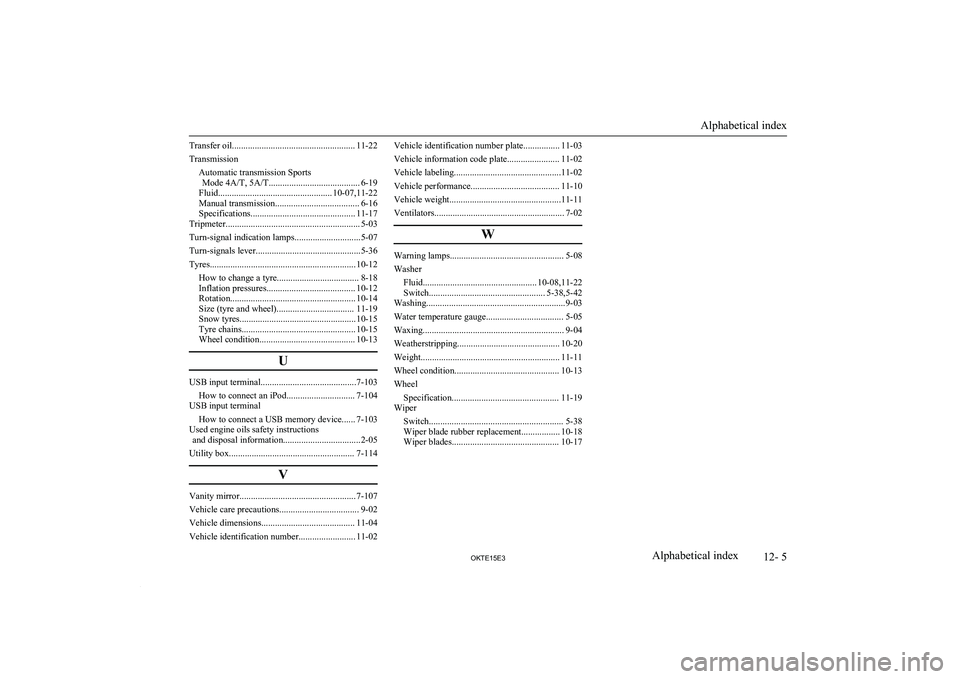
Transfer oil...................................................... 11-22
Transmission Automatic transmission SportsMode 4A/T, 5A/T........................................ 6-19
Fluid.................................................. 10-07,11-22
Manual transmission..................................... 6-16
Specifications.............................................. 11-17
Tripmeter........................................................... 5-03
Turn-signal indication lamps.............................5-07
Turn-signals lever..............................................5-36
Tyres................................................................ 10-12 How to change a tyre.................................... 8-18
Inflation pressures....................................... 10-12
Rotation....................................................... 10-14
Size (tyre and wheel).................................. 11-19
Snow tyres................................................... 10-15
Tyre chains.................................................. 10-15
Wheel condition.......................................... 10-13
U
USB input terminal..........................................7-103How to connect an iPod.............................. 7-104
USB input terminal
How to connect a USB memory device...... 7-103
Used engine oils safety instructions and disposal information..................................2-05
Utility box....................................................... 7-114
V
Vanity mirror................................................... 7-107
Vehicle care precautions................................... 9-02
Vehicle dimensions......................................... 11-04
Vehicle identification number......................... 11-02
Vehicle identification number plate................ 11-03
Vehicle information code plate....................... 11-02
Vehicle labeling...............................................11-02
Vehicle performance....................................... 11-10
Vehicle weight.................................................11-11
Ventilators......................................................... 7-02
W
Warning lamps.................................................. 5-08
Washer Fluid.................................................. 10-08,11-22
Switch................................................... 5-38,5-42
Washing.............................................................9-03
Water temperature gauge.................................. 5-05
Waxing.............................................................. 9-04
Weatherstripping............................................. 10-20
Weight............................................................. 11-11
Wheel condition.............................................. 10-13
Wheel Specification............................................... 11-19
Wiper
Switch........................................................... 5-38Wiper blade rubber replacement................. 10-18 Wiper blades............................................... 10-17
Alphabetical index
12- 5
OKTE15E3Alphabetical index